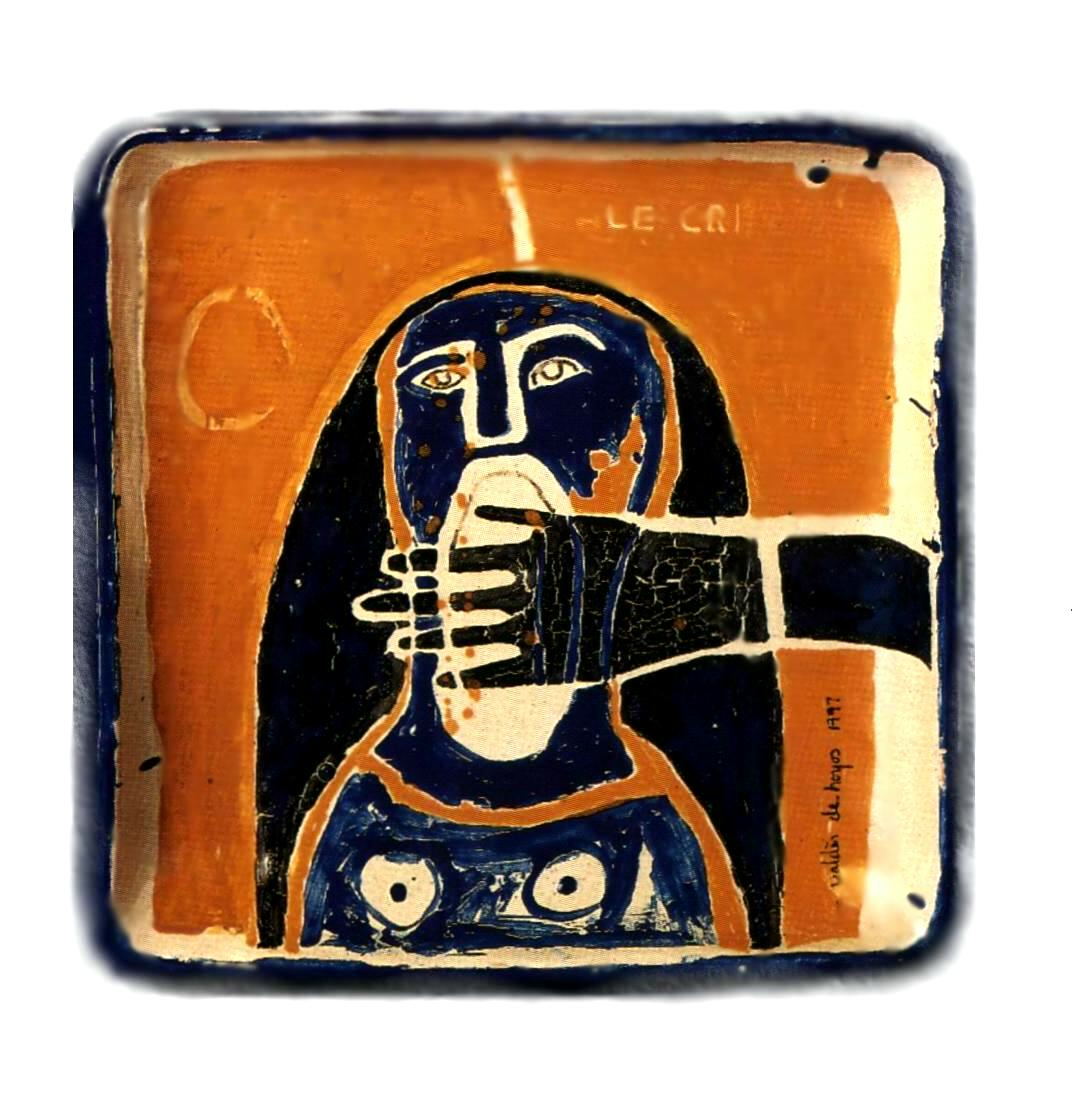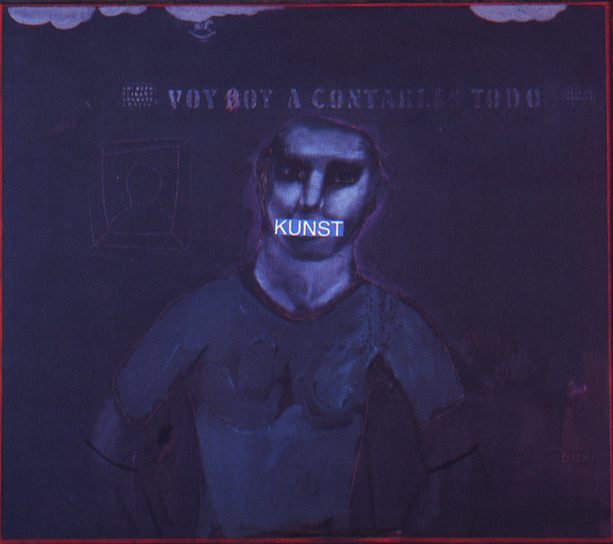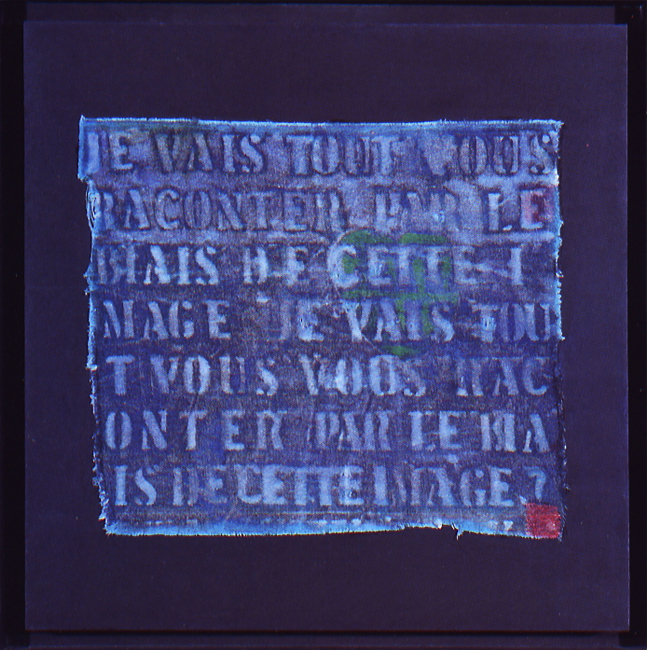MUSEO DEL PALACIO DE BELLAS ARTES, MÉXICO 1997
MEXICAN CULTURAL INSTITUTE, WASHINGTON 1998
LÖWENPALAIS STIFTUNG STARKE, BERLIN 1998
CUENTOS | STORIES
| "Ais das Kind Kind war, war es die Zeit der folgenden Fragen: warum bin ich ich und nicht Du? Warum bin ich ich und nicht da? Warum bin ich jetzt und nicht dann? Ist das Leben unter der Sonne nicht bloss ein Traum?" | ||
by Wim Wenders (Himmel über Berlin) |
||
|
ONLY A STORY AND OTHER RIDDLES - Image paradoxes in Remigio's messages by Anne Dattler Morales
Je vais tout vous raconter par le biais de cette image? - Denim on wood, artist's collection |
"The telling of an untrue or purely invented event,
either written or by word of mouth." Only a Story - a jaguar
that could have come from the cloister of Cuauhtinchan, a mestizo cloister,
taking concrete form on the colonial frescoes, an indigenous claw on the
murals of New Spain. In the labyrinth of his personal mythology, the
painter can lose his bearings, split among various systems, legacies, and
cardinal points. Chilam Balam, in English, the Interpreter of the Jaguar. He
who deciphers the secret language of the Masters, the riddles of the Suyua;
words that are only a story for the unenlightened public. We are faced with
the problem of ancient knowledge, a rite of passage. |
|
|
The identity of the painter takes root in different
legacies. The titles of the paintings build a Tower of Babel. With the
multiple languages used in baptizing the canvases, signifiers are hurled
about. Paradise: a clipping fixed on this painting from the
newspaper el País Dominical includes an ad in German; the donkey has the
French word "toucher" written on its haunch, and the protagonist's T-shirt
displays the words "My Heaven." To go to heaven one must pronounce the
founding word, prior to Babel, the vocals of the mantras or, like this
picture suggests, repeat the mythical, magical gesture that negates the
spoken word and lineal compréhension. Touching the amulet excites the
effectiveness of the original magic. |
||
|
The Babel-like title, Imagine, weaves a web of
interprétations with its diverse meanings in French, Italian, English. "Just
imagine, imagine it": the fantasy of the viewer becomes more important than
the painting. Image: upon naming the object, we return to the redundancy.
"Imagine all the people : idyllic fusion of the codes of communication.
The recurring frets in the works of Remigio reflect the maze of the
signifiers; in this pernicious thimble the conducting thread may well
disappear. |
||
|
Inédit - offers a reflection on the finality of
sacrifice and the possibility of a pictorial redemption. On the via
crucis of the painter, referred to here by the hammer and the lamb, the
images are in some way embargoed - the forbidding words of the
magazine and the tremendous interdiction of the hammer both engage us.
Notwithstanding the seriousness of the theme, the painter seeks shelter in
the double meaning, in the saving distancing by way of teasîng -
"You and I will be together until life overtakes us."
According to Remigio, in this Passion the concepts of life and death are
ironically interchangeable. The painter redeems himself with his sensual
Mexican treatment of doubt. Better to play with the signifiers, with
the trompe l'oeil, the jigsaw puzzle of art. From there, the collages.
The image uses the text, the newspaper clipping, fragmented, unintelligible.
From there, the subtle question marks, the delîberate will to repeat a
trivial redundancy, as in ridiculing those who are numb, laughing at the
equation between signified and signifier. |
 |
|
|
|
Le Cri - Talavera ceramics, Puebla México |
|
|
|
||
|
" I'm going to tell it all" ("Voy boy a contarles todo").
The humor is silenced, crushed by the Germanic incursion of epistemology.
Kunst: art stops being a cognitive option. It transforms itself into a gag
over the painter's mouth. The répression is brutal, reminiscent of the films
of Kubrick. Art is not light, but rather shadows. lt has stopped being the
fiat lux of creation. In the darkness of the canvas, one manages to discern
the letters of the alphabet, from A to Z. Letters devoid of syntax and
semantics, letters as disperse signs, a weakened system. |
||
|
The répression of Kunst whose protagonist is gaged by art. Terrible silence of Le Cri whose shriek is repressed by a Talavera "shut-your-mouth-up." The change in technique does not allow evading the question: "Je vais tout vous raconter...." What could this saint-martyr possible tell, a laughable reference to Edvard Munch, whose despair is drowned by a black hand?
Kunst - Mixed media on wood, Munich Germany |
||
 |
Hand, black hand, saint's hand. This escape has as its
counterpart different amulets and relics, probably to conjure the impotence
of the signifier. Arms, donkeys and boats are miracles scattered on the
canvas. One could also invoke the hand of Judas, or that anonymous hand that,
on colonial frescoes, points to the five wounds on Christ's body. The
lexicon of the crucifixion clashes with the staircase, the sword and the
hammer. The donkeys remind us of the small Mexican mules of Corpus Christi,
festival of the death and résurrection. But this central role of the
sacrifice does not resolve the existential doubt: "Better late/death/than
always/life" suggests A Story of Paradise. |
|
|
Loup: frets and spirals indicate the presence of a
labyrinth whose center is accessible only to the initiated. The woman
sleepwalker who blindly steps through the labyrinthe of the palace could be
Ariana; but her candle and the light that shines from her pilgrimage makes
her seem like a priestess, maybe that of Arcano Il. The woman surrounds
herself with great authority and blocks entrance to the néophytes. Meanwhile,
a small Saint George, with his faithful sword, seeks to liberate us from the
beast, from the Minotaur which we carry within. Taurine-man, donkey-man,
wolf-man, the loup to be defeated dwells in the labyrinth of our unconscious. |
||
|
Mitla's frets. The need for sacrifice. This Oaxacan
virgin died immolated on the canvas in order to feed the personai mythology
of the painter. Cometa: strange bisexual word from the Castilian language. The sacrifice could resuscitate the androgynous being of before the
séparation of the genders. Frets. Labyrinth. Migration in search of the
mythical Aztlàn. |
||
|
Seeking the Holy Grail, the ring, Clover: the gigantic
clover astonishes the child with its unreachable chalice. Leaves, three by
three. The fourth invisible leaf appears on the denim. The epiphany
materializes on a prosaic and secular canvas of blue jeans. Clover takes us
back to the search for the miracle, but, above all else, signifies the
multiplicité of media which serves to situate the artist's work in the
present time. The washed denim is comparable to the veil of Veronica. |
||
|
Ring: on the finger of the novice representing her
marriage to God. Golden nuptials of the priestess. Sacrifice. The
central hand, naked, still carries the bloody scar left f rom the nail- the
ring in not on the ring finger, but on the numb lips of the woman. Ring, the
comma of the word that seeks to resuscitate the riddles of Suyua. The
circular time of the "katunes" seeks to impose itself upon the lineal time
of the crucifixion. |
||
|
Mask - the counterpoint of the ring reappears.
Saturnalian perimeter that limits the 'Talavera plate -- ring worn by
another's hand -- paradoxically, the hand is not that of the
protagoniste but rather that of a third person who displays that symbol of
power. Evil ring like those of the Nibelungen. Also present in this series,
the black hand de profundis, imposing penance on the one who removes his
mask. The Unconscious-Minotaur prevents us from speaking, screaming,
breaking his spell. Will the artist's perseverance manage to liberate
him from these hands, from these evils that silence and afflict him? |
||
|
Another Story - "Warum bin ich ich und
nicht Du?" Why the original separation, the expulsion from
paradise, the rupture with Genesis? Why the sudden appearance of the
Other? And why your otherness? In other times, we were Brauner's
Androgyne, who eternally regenerated itself. And Narcissus was not
ashamed when he looked at himself in the waters of the twin-love. "Ou se
penserait-il mieux que dans les images?" as Bachelard would say. |
||
|
Mine - the image, reflection of oneself, the painting
revisited by psychoanalysis. The artist knows the determinisms of childhood. The use of crayon for this self-portrait allows the painter to return to the
time when he was a child. The incandescence, the orange colors, show the way
out from the labyrinthe Once the internal Minotaur is defeated, the I comes
out of the darkness. The multiple I, the I with superimposed strata,
the vermillon I free from the inter-text ( the newspaper clipping dies
beneath the oil ), the I, veil of sanctity. Appropriation of the reflection,
of the face, of Remystery. |
|
Ein mexikanisch-deutsches Austauschprojekt |
||
|
In zwei Ausstellungen werden Werke von Remigio Valdés
de Hoyos und von Dieter Finke gezeigt, der eine ist Künstler aus Mexiko, der
andere aus Deutschland. Zwei Orte, aber ein Projekt. Eine mexikanische
Institution präsentiert den Maler und Bildhauer Finke, eine deutsche den
Maler und Keramiker Valdés de Hoyos. Zwei Künstler im Austausch. Damit wird
eine Tradition fortgesetzt, die dem beidseitigen Kennenlernen zweier
unterschiedlicher Kulturen dient und zudem die beiden Metropolen und
Partnerstädte Berlin und Mexiko-Stadt näher bringt. |
||
|
In diesem Jahrhundert haben deutscher Expressionismus
und Realismus in der mexikanischen Kunst, andererseits Wandmalerei und
sozialkritische Grafik aus Mexiko in deutscher Kunst ihre Spuren
hinterlassen. Mit den Werken von Beckmann, Kirchner, Grosz und Kollwitz
dürfte man in Mexiko so vertraut sein wie mit denen von Orozco, Rivera,
Siqueiros und Tamayo in Deutschland. Beispielhaft hat sich Geben und Nehmen
auch in Arbeit und Einfluß einzelner deutscher Exilanten niedergeschlagen,
die in Mexiko vor der Nazidiktatur Zuflucht fanden. |
||
|
Wie kein anderer hat nach dem Krieg vor allem Mathias
Goeritz - Maler, Bildhauer und Architekt - in Mexiko als Mittler zwischen
den Kontinenten und mit seinem Werk in beide Richtungen gewirkt. Mexikanische Künstler zu Gast in Deutschland wie zuletzt der daad-Stipendiat
Gabriel Orozco in Berlin - auch das bestärkt die gegenseitigem Bande. |
||
|
Neben Austausch auf der individuellen Ebene bildet der
institutionelle eine notwendige Ergänzung und eine wesentliche Basis zum
Verständnis des anderen. In beiden deutschen Staaten fand mexikanische Kunst
in vielen Ausstellungen ein breites Publikum, und deutsche Kunstschätze
reisten über den Ozean. Das vereinte Deutschland, so steht zu hoffen, wird
diese Tradition fortsetzen. Mexiko als Schwerpunkt der Frankfurter Buchmesse
von 1992 bildete einen verheißungsvollen Auftakt. Mexikanische Museen zeigen
immer wieder Gegenwartskunst aus Deutschland, und kürzlich erhielt der Maler
Jörg Immendorf den angesehenen Preis des Museums für Zeitgenössische Kunst
in Monterrey. |
||
|
Die Ausstellungen von Remigio Valdés de Hoyos und
Dieter Finke stellen einen direkten, zeitlich parallelen Austausch aus. sie
stehen für die wachsende Kontinuität und Intensität der Beziehungen und die
gegenseitige Bereitschaft, mehr voneinander zu erfahren und einander besser
zu verstehen. |
||
|
Kunstwissenschaftler, Berlin -- Deutschland |
||
|
by Michael Nungesser |
|
